Pritzker Architecture Prize facts for kids
Quick facts for kids Pritzker Architecture Prize |
|
|---|---|
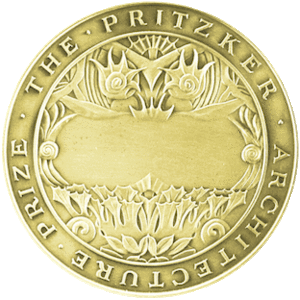
Medal of the Pritzker Architecture Prize
|
|
| Reward | US$100,000 |
| First awarded | 1979 |
The Pritzker Architecture Prize is a very important international award. It is given out every year to a living architect or group of architects. The award honors those whose buildings show great talent, new ideas, and a strong dedication to making the world better through architecture.
The Pritzker Prize started in 1979. It was created by Jay A. Pritzker and his wife Cindy. The Pritzker family helps pay for the award, and the Hyatt Foundation supports it. Many people think it is one of the best architecture awards in the world. It is often called the "Nobel Prize of architecture."
Contents
How Winners Are Chosen
The Pritzker Architecture Prize Jury chooses winners "no matter their nationality, race, beliefs, or ideas." This means anyone can win! Winners receive US$100,000, a special certificate, and a bronze medal.
The medal's design is inspired by the architect Louis Sullivan. On the back of the medal, there are Latin words: firmitas, utilitas, venustas. These words mean "firmness, commodity, and delight" in English. They come from an Ancient Roman architect named Vitruvius. Before 1987, winners also received a special sculpture by Henry Moore.
The Selection Process
The prize's executive director, Manuela Lucá-Dazio, asks many people for nominations. These people include past winners, teachers, critics, and others who know a lot about architecture. Any licensed architect can also apply for the prize themselves before November 1 each year. For example, in 1988, Gordon Bunshaft nominated himself and won!
A jury of five to nine experts then decides the winner. These experts are professionals in architecture, business, education, publishing, and culture. They announce the winner early the next year. The current head of the jury is Alejandro Aravena, who won the prize in 2016.
Amazing Architects: The Laureates
The first winner in 1979 was Philip Johnson. He was honored for 50 years of creative and lively work. His buildings included museums, theaters, libraries, homes, and offices.
In 2004, Zaha Hadid became the first woman to win the prize. Ryue Nishizawa was the youngest winner in 2010; he was 44 years old. Sometimes, two architects share the award. This happened in 2001 with Jacques Herzog and Pierre de Meuron. It also happened in 2010, 2020, and 2021. In 1988, Gordon Bunshaft and Oscar Niemeyer both won the award separately. In 2017, Rafael Aranda, Carme Pigem, and Ramon Vilalta were the first group of three to share the prize.
The most recent winner, for 2025, is Liu Jiakun from China.
| Year | Laureate(s) | Nationality | Photo | Example work (year completed) | Award ceremony location | Ref. | |
|---|---|---|---|---|---|---|---|
| 1979 | Philip Johnson | United States |  |
 |
Glass House (1949) | Dumbarton Oaks, Washington DC | |
| 1980 | Luis Barragán | Mexico |  |
 |
Cuadra San Cristóbal (1968) | Dumbarton Oaks, Washington DC | |
| 1981 | James Stirling | United Kingdom |  |
 |
Seeley Historical Library (1968) | National Building Museum, Washington DC | |
| 1982 | Kevin Roche | Ireland United States |
 |
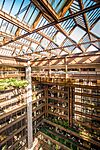 |
Ford Foundation Building (1967) | Art Institute of Chicago | |
| 1983 | I. M. Pei | United States | 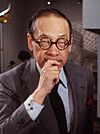 |
 |
National Gallery of Art, East Building (1978) | Metropolitan Museum of Art, New York City | |
| 1984 | Richard Meier | United States |  |
 |
High Museum of Art (1983) | National Gallery of Art, Washington DC | |
| 1985 | Hans Hollein | Austria | 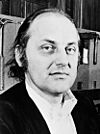 |
 |
Abteiberg Museum (1982) | The Huntington Library, San Marino, California | |
| 1986 | Gottfried Böhm | Germany (West Germany) |
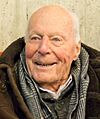 |
 |
Church of the Pilgrimage (1968) | Worshipful Company of Goldsmiths, London | |
| 1987 | Kenzō Tange | Japan | 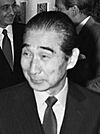 |
 |
St. Mary's Cathedral, Tokyo (1964) | Kimbell Art Museum, Fort Worth, Texas | |
| 1988 | Gordon Bunshaft (shared prize) |
United States |  |
Beinecke Rare Book and Manuscript Library (1963) | Art Institute of Chicago | ||
| Oscar Niemeyer (shared prize) |
Brazil |  |
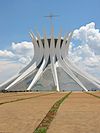 |
Cathedral of Brasília (1958) | |||
| 1989 | Frank Gehry | Canada United States |
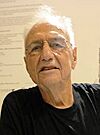 |
 |
Gehry Residence (1978) | Tōdai-ji, Nara, Japan | |
| 1990 | Aldo Rossi | Italy | 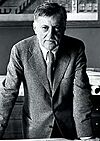 |
 |
San Cataldo Cemetery (1978) | Palazzo Grassi, Venice | |
| 1991 | Robert Venturi | United States | 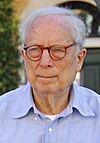 |
 |
National Gallery, Sainsbury Wing (1991) | Palace of Iturbide, Mexico City | |
| 1992 | Álvaro Siza Vieira | Portugal | 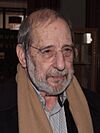 |
 |
Leça Swimming Pools (1966) | Harold Washington Library, Chicago | |
| 1993 | Fumihiko Maki | Japan |  |
 |
Tokyo Metropolitan Gymnasium (1991) | Prague Castle | |
| 1994 | Christian de Portzamparc | France |  |
 |
City of Music (1995) | The Commons, Columbus, Indiana | |
| 1995 | Tadao Ando | Japan | 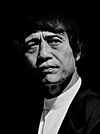 |
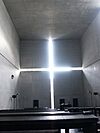 |
Church of the Light (1989) | Petit Trianon, Versailles | |
| 1996 | Rafael Moneo | Spain |  |
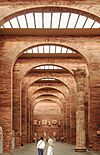 |
National Museum of Roman Art (1986) | Getty Center, Los Angeles | |
| 1997 | Sverre Fehn | Norway | 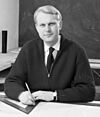 |
 |
Norwegian Glacier Museum (1991) | Guggenheim Museum Bilbao | |
| 1998 | Renzo Piano | Italy | 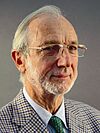 |
 |
Kansai International Airport (1994) | White House, Washington DC | |
| 1999 | Norman Foster | United Kingdom | 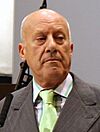 |
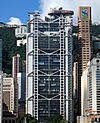 |
HSBC Building (1985) | Altes Museum, Berlin | |
| 2000 | Rem Koolhaas | Netherlands | 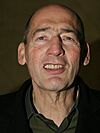 |
 |
Kunsthal (1992) | Jerusalem Archaeological Park | |
| 2001 | Jacques Herzog & Pierre de Meuron | Switzerland | 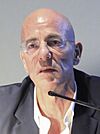 |
 |
Tate Modern (2000) | Monticello, Charlottesville, Virginia | |
| 2002 | Glenn Murcutt | Australia | 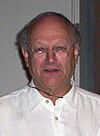 |
 |
Berowra Waters Inn (1983) | Campidoglio, Rome | |
| 2003 | Jørn Utzon | Denmark |  |
Sydney Opera House (1973) | Royal Academy of Fine Arts of San Fernando, Madrid | ||
| 2004 | Zaha Hadid | Iraq United Kingdom |
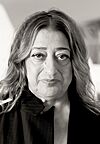 |
 |
Bergisel Ski Jump (2003) | Hermitage Museum, Saint Petersburg | |
| 2005 | Thom Mayne | United States | 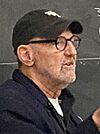 |
 |
Caltrans District 7 Headquarters (2004) | Pritzker Pavilion, Chicago | |
| 2006 | Paulo Mendes da Rocha | Brazil | 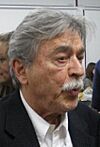 |
 |
Saint Peter Chapel, Campos do Jordão, São Paulo (1987) | Dolmabahçe Palace, Istanbul | |
| 2007 | Richard Rogers | Italy United Kingdom |
 |
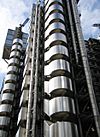 |
Lloyd's building (1986) | Banqueting House, Whitehall, London | |
| 2008 | Jean Nouvel | France | 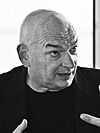 |
 |
Torre Agbar (2005) | Library of Congress, Washington DC | |
| 2009 | Peter Zumthor | Switzerland |  |
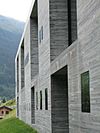 |
Therme Vals (1996) | Legislative Palace of the City Council, Buenos Aires | |
| 2010 | Kazuyo Sejima and Ryue Nishizawa | Japan | 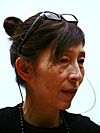 |
 |
21st Century Museum of Contemporary Art, Kanazawa (2003) | Ellis Island, New York City | |
| 2011 | Eduardo Souto de Moura | Portugal | 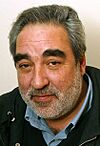 |
 |
Estádio Municipal de Braga (2004) | Andrew W. Mellon Auditorium, Washington DC | |
| 2012 | Wang Shu | China | 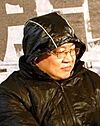 |
 |
Ningbo Museum (2008) | Great Hall of the People, Beijing | |
| 2013 | Toyo Ito | Japan | 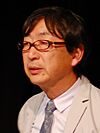 |
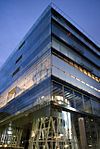 |
Sendai Mediatheque (2001) | John F. Kennedy Presidential Library and Museum, Boston | |
| 2014 | Shigeru Ban | Japan | 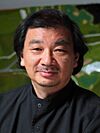 |
 |
Centre Pompidou-Metz (2010) | Rijksmuseum, Amsterdam | |
| 2015 | Frei Otto | Germany |  |
Olympic Stadium, Munich (1972) | New World Center, Miami | ||
| 2016 | Alejandro Aravena | Chile |  |
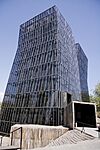 |
Siamese Towers, Pontifical Catholic University of Chile (2005) | United Nations Headquarters, New York City | |
| 2017 | Rafael Aranda, Carme Pigem, and Ramon Vilalta | Spain |
|
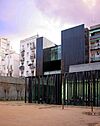 |
Sant Antoni Library, Barcelona (2008) | Akasaka Palace, Tokyo | |
| 2018 | B. V. Doshi | India | 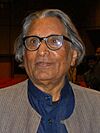 |
 |
Indian Institute of Management Bangalore (1977–1992, multiple phases) | Aga Khan Museum, Toronto | |
| 2019 | Arata Isozaki | Japan | 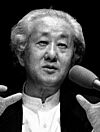 |
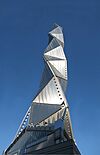 |
Art Tower Mito (1990) | Palace of Versailles | |
| 2020 | Yvonne Farrell and Shelley McNamara | Ireland |  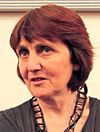 |
 |
The Grafton Building of Bocconi University (2007) | Online | |
| 2021 | Anne Lacaton and Jean-Philippe Vassal | France |  |
 |
National School of Architecture, Nantes (2009) | Online | |
| 2022 | Diébédo Francis Kéré | Burkina Faso Germany |
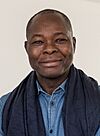 |
 |
Centre for Earth Architecture, Mopti, Mali (2010) | London School of Economics and Political Science (LSE) Marshall Building, London | |
| 2023 | David Chipperfield | United Kingdom | 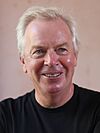 |
 |
Neues Museum, Berlin (1997–2009) | Ancient Agora of Athens | |
| 2024 | Riken Yamamoto | Japan | 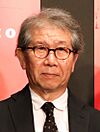 |
Yokosuka Museum of Art, Kanagawa, Japan (2007) | Art Institute of Chicago | ||
| 2025 | Liu Jiakun | China |  |
West Village, Chengdu, China (2015) | Louvre Abu Dhabi | ||
Notes About Winners
- A. Kevin Roche was born in Ireland.
- B. I. M. Pei was born in China.
- C. Frank Gehry was born in Canada.
- D. Zaha Hadid was born in Iraq.
- E. Richard Rogers was born in Italy.
- F. Frei Otto received his award after he had passed away.
- G. The 2020 and 2021 ceremonies were held online because of the COVID-19 pandemic.
- H. Diébédo Francis Kéré was born in Burkina Faso.
- I. Riken Yamamoto was born in China when it was under Japanese control.
Learn More
- Driehaus Architecture Prize
- List of architecture awards
- List of prizes known as the Nobel of a field or the highest honors of a field
See also
 In Spanish: Premio Pritzker para niños
In Spanish: Premio Pritzker para niños

